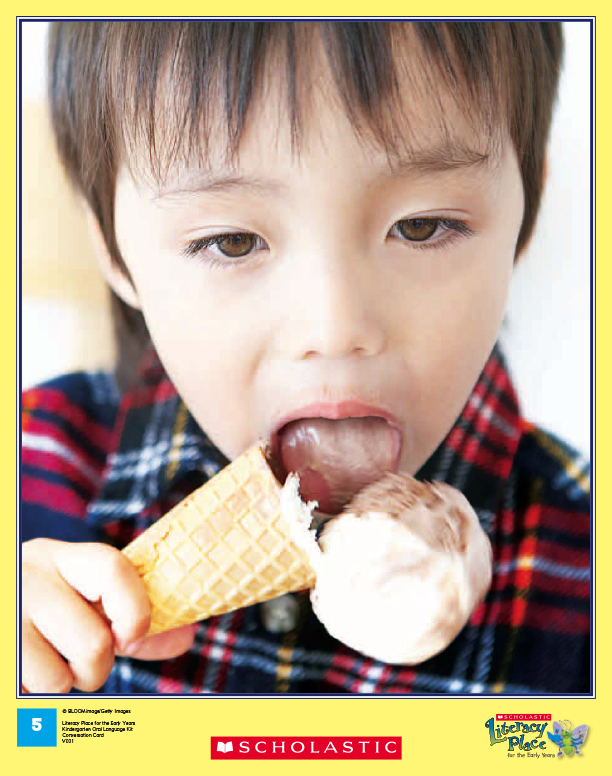Model Eye Contact When Listening Model powerful listening by making eye contact with the person who is speaking to you.
Time: one 30-minute lesson or two 15-minute lessons
Materials: Emotions/Interactions Card #5
Grouping: whole class or small group
Assessment: Kindergarten Oral Language Assessment Scale
FOCUSING ON THE PICTURE
[Analyzing/inferring]-
What do you see happening in the picture?
Show students the picture. Ask them to look at it and think about what they see and what they think is happening.
-
After students have had time to closely analyze the picture, have them turn to a partner and share their thinking. Remind them to be good listeners and to look at their partner when they are speaking. Model how you should sit and look at your partner with a student in the class, eye to eye, knee to knee.
- Provide time for partner discussion and then have a few of the students share their thinking with the larger group.
[Analyzing/inferring]
- Offer prompts to stimulate discussion:
- Who do you think the boy in this picture is? Let’s give him a name.
- What clues can we use to figure out what is happening in this picture?
- What will he do next?
GOING DEEPER
[Inferring/evaluating]- Offer prompts that focus the students on the emotions portrayed in the picture:
- How do you think the boy is feeling? What clues tell you this? What is his mouth doing? His eyes?
- What do you think the boy might say next?
- If this happened to you what would you do? What would you say?
-
If you were standing beside a friend and the ice cream fell from their cone, what would you say to your friend? What would make your friend feel better? How could you help your friend?
Have students turn to their partner again and think about what they would say to the boy if they were his friend standing next to him when this happened. Invite several students to share their comments with the larger group.
You may conclude the lesson at this point and do the second part on the next day, or you may decide to continue and do Connecting and Predicting as part of the first lesson.
CONNECTING
Teaching Tip: If you decide to do Connecting and Predicting on the second day, begin your lesson by reviewing the picture with the students.
[Making connections]
- To encourage students to make connections to the boy in this picture, share a personal story about a time when you have lost the top of an ice cream cone.
Do a quick tally to find out how many students have had this happen to them. Prompts to deepen discussion might include: - Have you ever felt like the boy in this picture? How did you feel?
- How could you solve this problem?
- What would you say if this happened to your friend?
-
How did it make you feel when you dropped your ice cream? What did you do? Did anybody help you?
Offer specific prompts that fit the discussion you have had with the group.
PREDICTING
[Predicting]-
Ask students to think about what might happen next in this picture. As students share their ideas, make eye contact with them to show that you are listening closely to what they’re saying.
Maggie: I think the boy will be sad if he loses his ice cream. He might even cry.
Raiden: Maybe he’ll catch the ice cream before it falls on the ground. Then he won’t lose it and be sad.
Teacher: Good thinking Raiden. I like how you predicted that he might catch the ice cream. -
Brainstorm with students possible scenarios that may occur. Make sure to ask students why they think this will happen, ensuring they are building on the picture and discussions that have taken place.
LESSON EXTENSIONS
-
Brainstorm ideas with students on how to eat an ice cream cone so that the ice cream doesn’t fall off the cone. Then write a procedural text together on how to eat an ice cream cone. Post the shared writing at the art centre and invite students to draw or paint pictures to illustrate the text. Or post it at the drama centre and have students act out how to eat an ice cream cone.
-
Use the picture as the basis for a shared writing lesson. Invite students to brainstorm a few sentences about the picture. As you record these sentences, select students to share the pen with you. Have students who are not sharing the pen spell the words out loud or trace the words or initial letters on the floor.
-
You can return to the shared writing and read it as a shared reading text the next day or provide a copy of the shared writing text in the reading centre so students can return to it at a later time.
FOLLOW-UP IN CENTRES
-
Read the Literacy Place for the Early Years shared reading book, Making Ice Cream, with the students. You might make ice cream with the students at the science centre.
-
Post the picture at the writing centre and invite students to write their ideas about the picture on sticky notes and then stick them on the picture. You could review the notes with the students during a ‘reading walk’ in the class.
-
Provide paper cut-outs of ice cream cones and ice cream scoops in a variety of colours. Invite students to come to the math centre to make as many different kinds of ice cream cones as they can (different colours, numbers of scoops).

